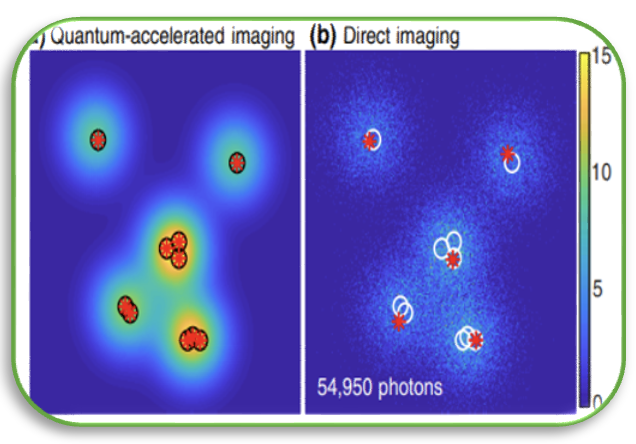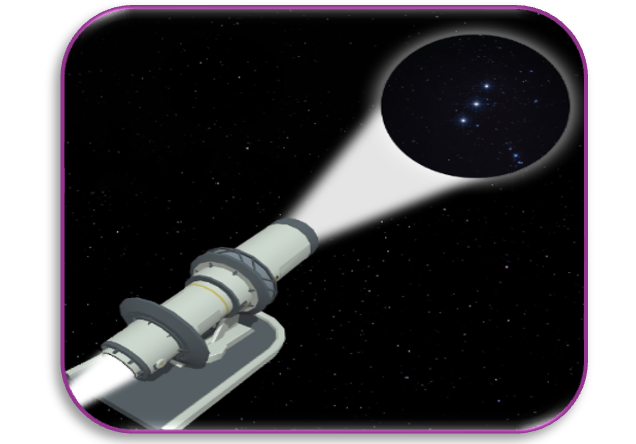Our research in this area exploits informative measurement system in both quantum and classical domains to enhance imaging capabilities, showcasing a smooth integration of theory and practical applications in astronomy and beyond. We can broadly categorize our work in the following categories. Click to know more!
Space Situational Awareness
Quantum Accelerated Imaging
Imaging point sources with low angular separation near or below the Rayleigh criterion is important in astronomy, e.g., in the search for habitable exoplanets near stars. However, the measurement time required to resolve stars in the sub-Rayleigh region via traditional direct imaging is usually prohibitive. We propose quantum-accelerated imaging (QAI) to significantly reduce the measurement time using an information-theoretic approach. QAI achieves quantum acceleration by adaptively learning optimal measurements from data to maximize Fisher information per detected photon. Our approach can be implemented experimentally by linear-projection instruments followed by a single-photon detector array. We estimate the position, brightness and the number of unknown stars 10 ∼ 100 times faster than direct imaging with the same aperture. QAI is scalable to large number of incoherent point sources and can find widespread applicability beyond astronomy to high-speed imaging, fluorescence microscopy and efficient optical read-out of qubits.
Sub-Rayleigh Imaging
The Rayleigh limit and low Signal-to-Noise Ratio (SNR) scenarios pose significant limitations to optical imaging systems used in remote sensing, infrared thermal imaging, and space domain awareness. In this study, we introduce a Stochastic Sub-Rayleigh Imaging (SSRI) algorithm to localize point objects and estimate their positions, brightnesses, and number in low SNR conditions, even below the Rayleigh limit. Our algorithm adopts a maximum likelihood approach and exploits the Poisson distribution of incoming photons to overcome the Rayleigh limit in low SNR conditions. In our experimental validation, which closely mirrors practical scenarios, we focus on conditions with closely spaced sources within the sub-Rayleigh limit (0.49-1.00R) and weak signals (SNR less than 1.2). We use the Jaccard index and Jaccard efficiency as a figure of merit to quantify imaging performance in the sub-Rayleigh region. Our approach consistently outperforms established algorithms such as Richardson-Lucy and CLEAN by 4X in the low SNR, sub-Rayleigh regime. Our SSRI algorithm allows existing telescope-based optical/infrared imaging systems to overcome the extreme limit of sub-Rayleigh, low SNR source distributions, potentially impacting a wide range of fields, including passive thermal imaging, remote sensing, and space domain awareness.
Remote Sensing at the Shot Noise Limit
Photon statistics of an optical field can be used for quantum optical sensing in low light level scenarios free of bulky optical components. However, photon-number-resolving detection to unravel the photon statistics is challenging. Here, we propose a novel detection approach, that we call ‘photon discerning’, which uses adaptive photon thresholding for photon statistical estimation without recording exact photon numbers. Our photon discerner is motivated by the field of neural networks where tunable thresholds have proven efficient for isolating optimal decision boundaries in machine learning tasks. The photon discerner maximizes Fisher information per photon by iteratively choos- ing the optimal threshold in real-time to approach the shot noise limit. Our proposed scheme of adaptive photon thresholding leads to unique remote-sensing applications of quantum DoLP (degree of linear polarization) camera and quantum LiDAR. We investigate optimal thresholds and show that the optimal photon threshold can be counter-intuitive (not equal to 1) even for weak signals (mean photon number much less than 1), due to the photon bunching effect. We also put forth a superconducting nanowire realization of the photon discerner which can be experimentally imple- mented in the near-term. We show that the adaptivity of our photon discerner enables it to beat realistic photon-number-resolving detectors with limited photon-number resolution. Our work suggests a new class of detectors for information-theory driven, compact, and learning-based quantum optical sensing.




